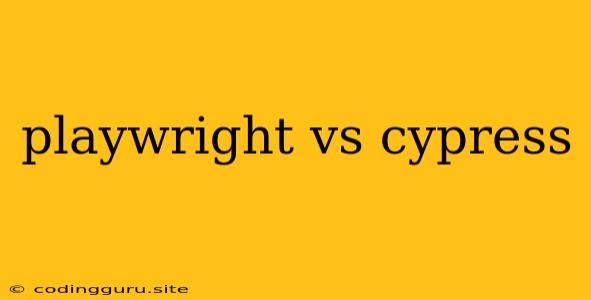Playwright vs Cypress: Which Testing Framework is Right for You?
Choosing the right testing framework is crucial for ensuring the quality and stability of your web applications. Two popular contenders in the automation testing landscape are Playwright and Cypress. Both offer a range of features and capabilities, but understanding their strengths and weaknesses can help you make an informed decision.
What is Playwright?
Playwright is a powerful and versatile automation framework developed by Microsoft. It allows you to write tests for web applications using a single API for multiple browsers, including Chrome, Firefox, Safari, and Chromium-based browsers.
Key Features of Playwright
- Cross-browser compatibility: Playwright excels in its support for different browsers, enabling you to test your application consistently across various platforms.
- Multi-language support: Playwright provides APIs for JavaScript, Python, .NET, and Java, making it accessible to a wide range of developers.
- Asynchronous execution: Playwright handles asynchronous operations efficiently, ensuring smooth test execution and reliable results.
- Debugging and tracing: Playwright offers robust debugging capabilities, allowing you to easily identify and resolve test failures.
- Mobile testing support: Playwright extends its functionality to mobile web testing, allowing you to test your applications on real devices or emulators.
What is Cypress?
Cypress is another widely adopted automation testing framework known for its ease of use and developer-friendly features. It primarily focuses on front-end testing and excels in testing user interactions within a web application.
Key Features of Cypress:
- End-to-end testing: Cypress is designed for end-to-end testing, simulating user interactions and verifying application behavior.
- Real-time feedback: Cypress provides real-time feedback during test execution, making it easier to identify issues and debug tests.
- Time travel debugging: Cypress allows you to step back through the execution of your tests, making it simple to understand why a test failed.
- Automatic waiting: Cypress handles asynchronous operations automatically, eliminating the need for manual waits and improving test reliability.
- Mock network requests: Cypress provides functionalities for mocking network requests, enabling you to test your application in isolated environments.
Playwright vs Cypress: A Detailed Comparison
| Feature | Playwright | Cypress |
|---|---|---|
| Cross-browser support | Excellent | Limited to Chromium-based browsers |
| Multi-language support | Yes | JavaScript only |
| Asynchronous execution | Efficient | Good, but requires manual handling in some cases |
| Debugging and tracing | Excellent | Good, but less comprehensive |
| Mobile testing support | Yes | No |
| End-to-end testing | Yes | Excellent |
| Real-time feedback | Available | Excellent |
| Time travel debugging | Available | Excellent |
| Automatic waiting | Yes | Yes |
| Mock network requests | Yes | Yes |
| Ease of use | Moderately easy | Easier |
| Community support | Growing rapidly | Large and active |
| Documentation | Comprehensive and well-written | Excellent |
When to Choose Playwright?
Consider Playwright if:
- You need to test your application across multiple browsers, including Firefox and Safari.
- You are using a programming language other than JavaScript.
- You need to test your application on mobile devices.
- You prioritize comprehensive debugging and tracing capabilities.
When to Choose Cypress?
Consider Cypress if:
- You are primarily focused on end-to-end testing.
- You prefer a framework with a steeper learning curve but more intuitive features.
- You need excellent real-time feedback and time travel debugging capabilities.
- You need to mock network requests effectively.
Conclusion
Choosing between Playwright and Cypress depends on your specific project requirements and priorities. Playwright is a versatile framework that excels in cross-browser compatibility, asynchronous execution, and debugging, while Cypress is known for its ease of use, real-time feedback, and end-to-end testing capabilities. Evaluate your project needs carefully and select the framework that best aligns with your testing goals.
